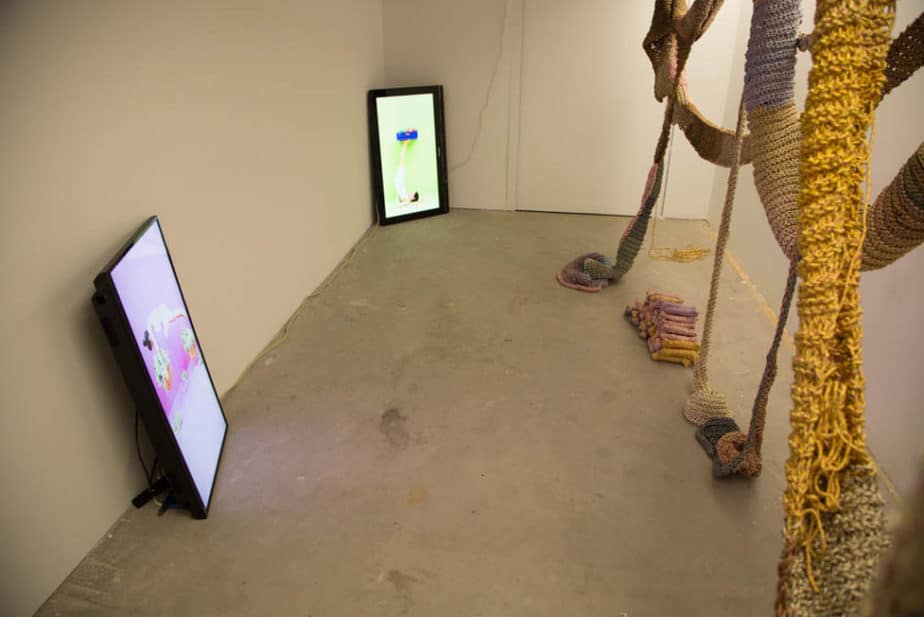It is entirely fitting that the current show exhibiting in the Bushwick space called Secret Dungeon is titled STAMINA. This two-woman show, curated by Alexandra Fanning, brings together two female artists from differing backgrounds exploring the universal psychological, social, and cultural ways of viewing and valuing the labor of women’s work.
Thai-Australian performance artist Kawita Vatanajyankur, presents candy-colored films featuring extremely strenuous poses in which her body is rendered a tool. Russian-American Liza Buzytsky has transformed the gallery space with her latest work, 200 Hours, a fiber installation influenced by “survival training” educational videos and sailor’s knots. Buzytsky will continue developing the work for the duration of the show, occupying the gallery space and continuing to explore the potential of her chosen material, clothesline.
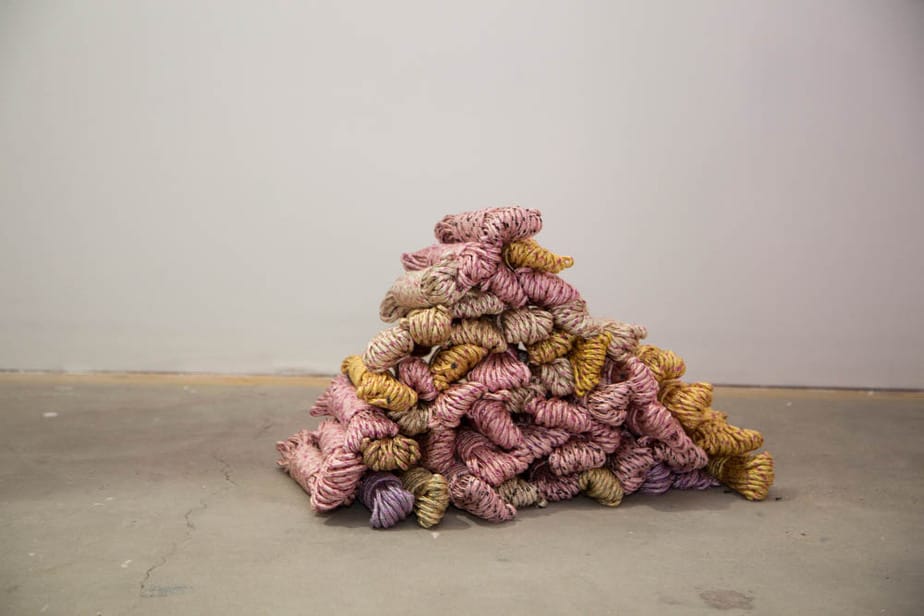
Both performative in their work, Buzytsky and Vatanajyankur strain their bodies, urging an examination of women’s roles in the domestic sphere. By highlighting the often overlooked and undervalued manual labor that women have endured throughout history, the pair emphasize domestic rituals and craft, redressing how traditional “women’s work” has been considered a lesser form of creativity than the finer arts.
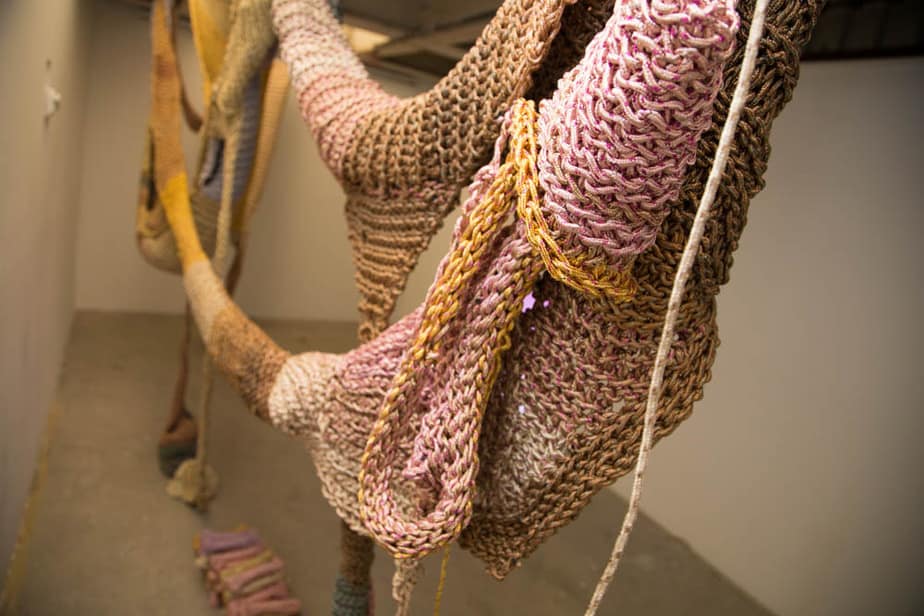
Buzytsky considers her work to be a “visual ethnography” She describes her work as being situated intentionally between art and ethnography, re-contextualizing, re-appropriating art-making as ethnography and ethnography as art-making.
The majority of her practice is rooted in family history and lineage, especially her personal experience of leaving the Soviet Union with her family. From a young age, the artist witnessed her mother proudly designing and sewing non-utilitarian clothing, using her skills to fight against the uniformity of her surroundings. Fibers, always embedded with narrative, are layered, stretched and manipulated to reveal the complexities of cultural exchange and encourage conversation. Buzytsky, in her practice, tasks herself with unpacking, observing and integrating these fragmented, visceral details into a new form, giving the materials new life.
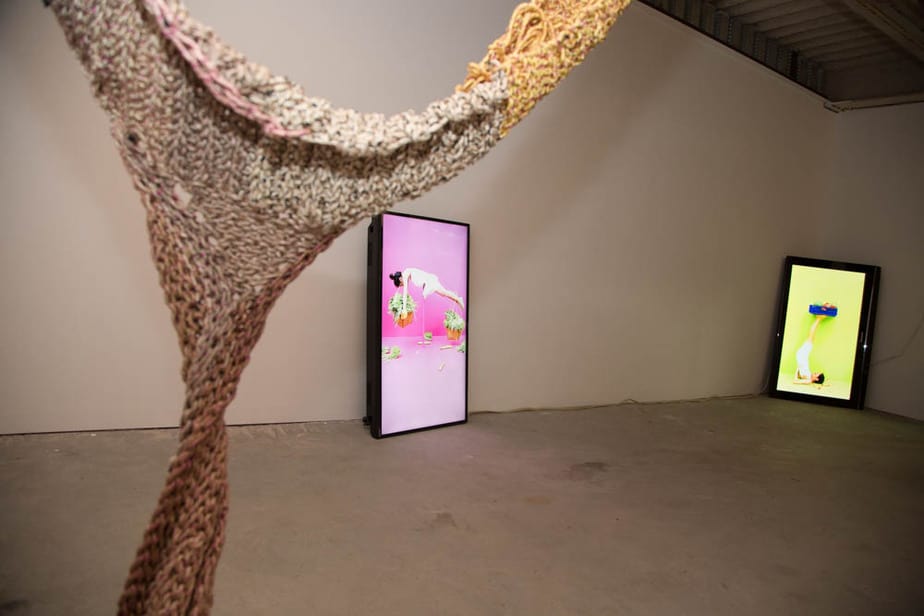
We spoke to Buzytsky about 200 Hours, craft, performance and the body, and the embedded history within fibers.
QL: Tell us about 200 Hours , why the title and what is the concept behind the work.
LB: The title describes the amount of time I will spend producing the work in the space by the time the exhibition closes on October 21st. My technique is finger crochet, which omits any tools and allows immediate contact or direct transmission of a gesture into the material. Imagine it like finger painting, but with rope.
200 hours is about five weeks of a 40 hour work week. It creates a parameter around this work, in addition to the parameters of the single material – clothesline and single technique – crochet. Having clear boundaries is a very liberating way to work, in that the creativity, the organic growth of the piece occurs within these clear rules. It is equally important for me to demystify the artistic process, to break the myth that a stroke of genius happens when one ‘feels like being creative’. I prescribe to the 99% perspiration, 1% inspiration model, where I need to show up in studio consistently whether I want to or not. There’s a romance to the perception of an artist’s life, but ultimately, it requires the rigor and discipline of any other job. The piece becomes a document or the time spent, physically indicative of what happens when one commits to a task. There’s no way to cheat that.
Additionally, art making has always run parallel to my yoga practice of 15 years, another thing that just takes consistency over time. I became a teacher just a few years back and 200 hours is generally a starting point for teacher training programs (as was mine) I’ve found that it is enough time to familiarize yourself with something, but it is far from expertise. When you’re finished with those 200 hours, the real work begins.
QL: We noticed that you use a variety of fibers in your work, why clothesline for this piece?
LB: I discovered the clothesline in my local Bushwick 99 cent store. I’ve always outfitted my Brooklyn apartments from the 99 cent store because it is practical and affordable, and you can find unusual things like this colored clothesline. Each 99 store has a very unique inventory, so it feels local and a bit like an adventure. I’ve noticed these stores are spaces where local people primarily shop including immigrants, artists, mothers and other workers. It is definitely related to class. Incidentally, my studio in Bushwick is also in a former 99 cent store warehouse! Clothesline references the textile industry overall, in its original function for drying clothes, which is becoming an obsolete task. How many people do you know of younger generations that dry their clothes on a clothes line? I know my mother still does it in her suburban Seattle home, and sometimes you see apartments in the city with a few things out to dry, but the idea of washing and drying by hand is slowly becoming extinct and replaced by laundry services and even disposable fast fashion. This clothesline comes in 30 feet segments, ideal for working modularly. When one skein ends, I attach the next one with a climbing knot. Working modularly is also something that allows me to take my work with me wherever I go. It prompts people to speak to me out in the world. I noticed a particularly gendered divide in that women primarily identified the fibers process and shared stories of their mothers and grandmothers knitting while men saw the clothesline as survival paracord and shared stories of hunting and fishing expeditions. I am thrilled to collect people’s stories and use the process of craft to start conversation and commune.
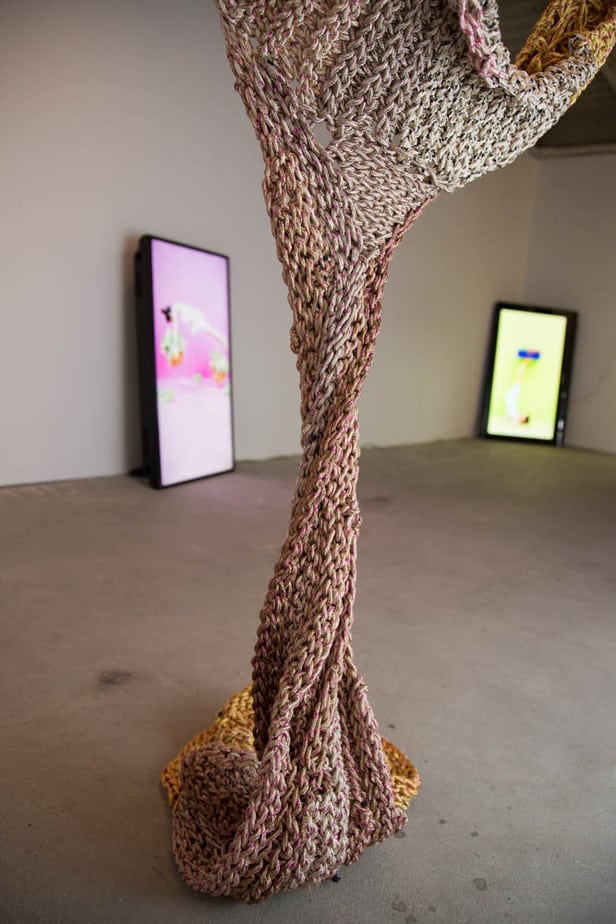
QL: You are using crochet techniques similar to that of Olek or Toshiko MacAdam. What sets you apart, why are you different?
LB: I would consider both artists as Art Grandmothers – a term we discuss a lot in my Fibers Collective SNAG. I see my practice as a kind of hybrid of lineages, everything I have ever seen makes its way into my work. Similar to MacAdam’s work, my sculptures invite touch and even play, but they are certainly intended for adults and reflect adult psychology. I dedicate myself to a fibers technique for the duration and needs of each project, rather than honing and mastering that technique continuously as in the case with Olek. My previous large scale installation Overt Symbols was braided together from thousands of men’s neckties, sourced from friends, family, lovers and strangers. I created a video & audio montage as a part of this piece, sourcing film and the internet tutorials. It examines the necktie’s role in the myth of American exceptionalism and the American dream. This is my first exclusively crocheted installation and I’m excited about the obsession and proficiency that is evolving, but I’m even more curious to see where this journey will lead next. I use fibers as a language of matrilineal history and an investigation of material culture and I will continue to grow this installation based work, taking on new techniques, methods and materials that best communicate my ideas and questions.
QL: You have a very strong connection to fibers, through your personal experiences with immigration and assimilation. Could you tell us a bit about that.
LB: When we first moved to America in the 1980’s, our laundry room was in our basement. It was a space both cool and protected, private and removed. When my mother and I would share secrets, or have important, sometimes painful conversations it would almost always happen in this basement, while she was washing clothes. The tears and struggle of assimilation to American culture during adolescence permeated those fibers. I often think about Louise Bourgeois description of the psychology of the house, and for me, the basement was analogous to the subconscious, that which rumbles underneath our active, aware thoughts, our censored social niceties. Our personal histories, lineages, idiosyncrasies hide out in the basement, and this is also where the laundry gets done. I find this an interesting process to contemplate as I work in another basement here at Secret Dungeon, a storage unit that takes on the life of whatever happens inside. For the sculpture Exit Visa, I started with the linens and bedsheets I remember first washing in that basement. These were the very first fabrics we slept on in this country. When you are essentially a refugee from another place, a warm bed with soft linens are monumental. All fibers are imbued with the touch of those who handle them, bedsheets and clothesline are no exception.
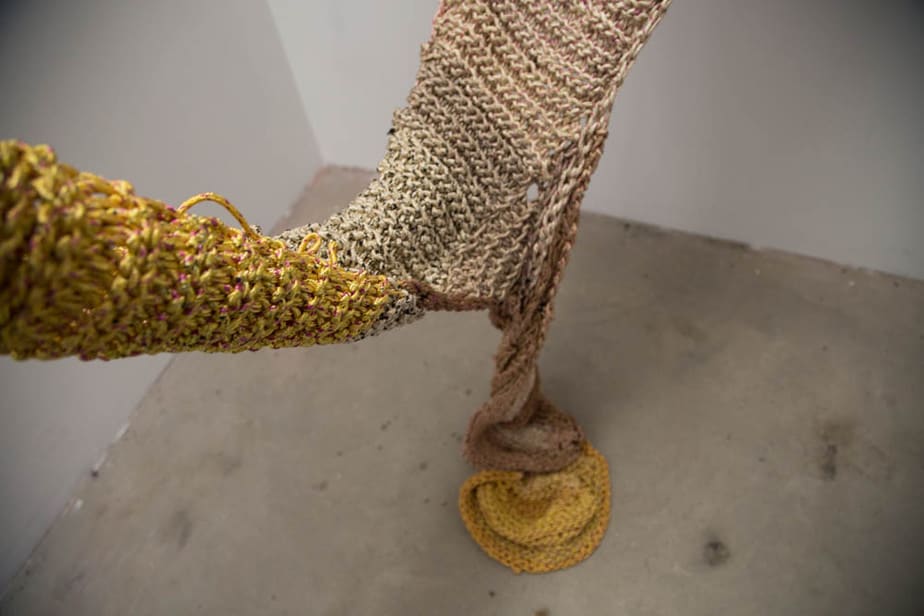
QL: What is the dialogue between your work and the work of Kawita V?
LB: Kawita’s investigation into the role of labor in the domestic sphere parallels my own questions, although our cultural backgrounds are distinct and methods quite different. Our bodies are both present in the work in different ways.The idea of not fully seeing or thinking about the labor behind the “beautifully packaged” products in the supermarket really resonates with me when I think about clothing industry and fast fashion.
I think we are both thinking about what is happening behind the scenes of domestic labor, of consumer goods, of aspects of women’s lives often hidden and we want to reveal these processes. We use color and texture to draw the viewer in. This process of seduction is important because it is disarming. By the time you realize that there’s violence or conflict underneath, its already too late to turn away and you’re compelled to grapple with those questions.
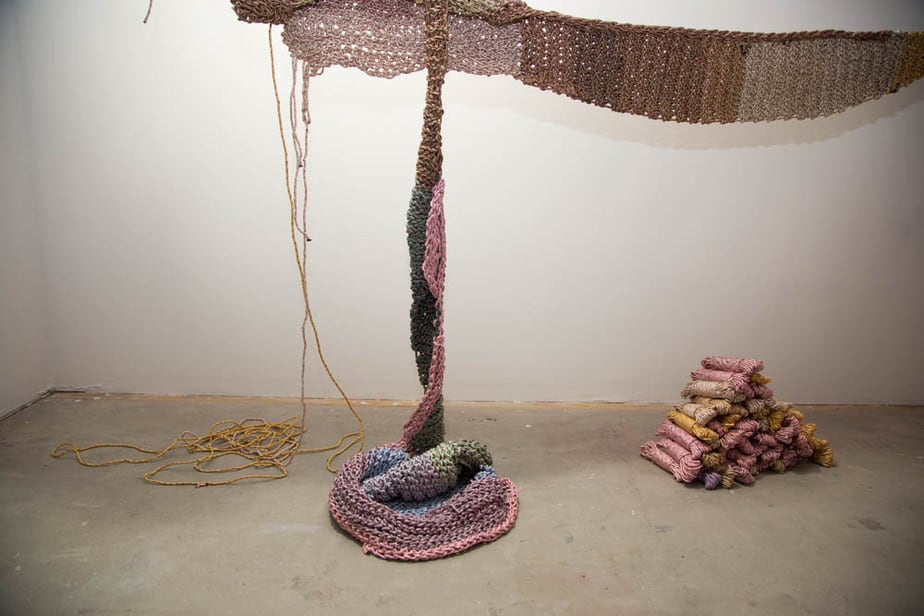
STAMINA will be on view September 10 – October 22, 2017, at Secret Dungeon 236 Moore Street, Brooklyn, NY (Entry Through the Garage Door on White Street). Photographs by Sam Robertson courtesy of the gallery.

Quiet Lunch is a grassroot online publication that seeks to promote various aspects of life and culture with a loving, but brute, educational tinge. When we say, “Creative Sustenance Daily,” we mean it.

